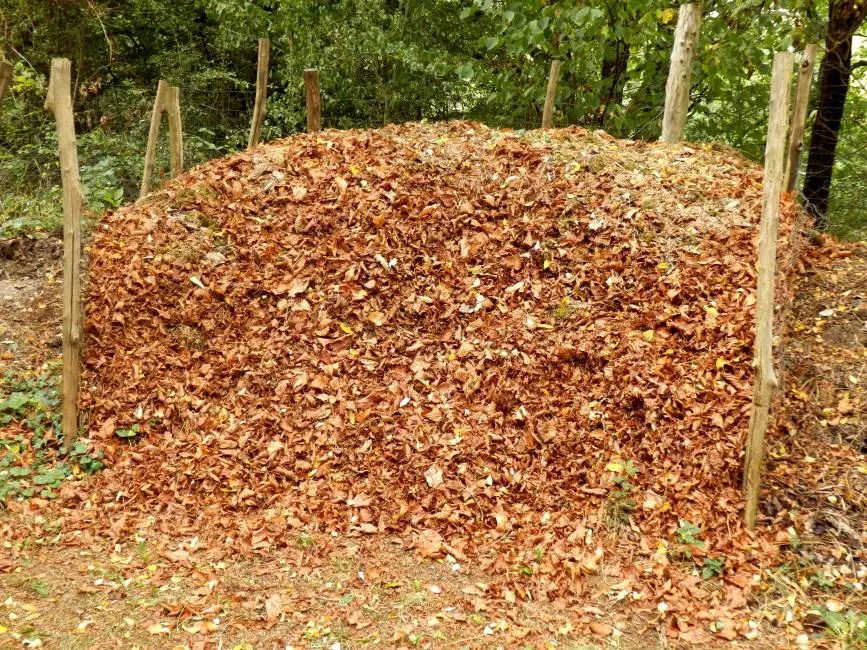Shredded leaves make an excellent addition to compost, or you can use them to make leaf mold. But the question of how to shred them can leave many people stumped.
The most common way to shred leaves for compost is to use a lawnmower. Most people already own a lawnmower, making this method cheap and convenient.
In this article, I go through exactly how to use your lawnmower to shred leaves, as well as some alternative options. These include using a weed eater, jumping on the leaves, and letting your chickens shred them for you.
How to shred leaves for compost
We’ve come up with seven ingenious ways for you to shred your leaves.
Some of them you might have heard of before, but others may come as a bit of a surprise (looking at you, chickens!).
Use a lawn mower
This is a popular option because most people already have a mower at home. Mulching mowers are the most efficient for this job, but any kind of lawnmower will work.
If you have a mower with a bag attachment, you can use this to collect the leaves (plus some nitrogen-rich lawn clippings). But if not, don’t worry, you can just rake the shredded leaves up afterwards.
There are several different ways to go about mowing your leaves.
Some people like to spread them out over the entire lawn and then leave a thin layer of leaves there to act as lawn mulch.
Others like to rake the leaves into a pile and then push their mower straight into the middle.
The best thing to do is experiment and see what works for you.
Use a weed wacker
This is one of the quickest methods of shredding leaves. However, it’s also very dusty and loud, so make sure you wear the appropriate protection.
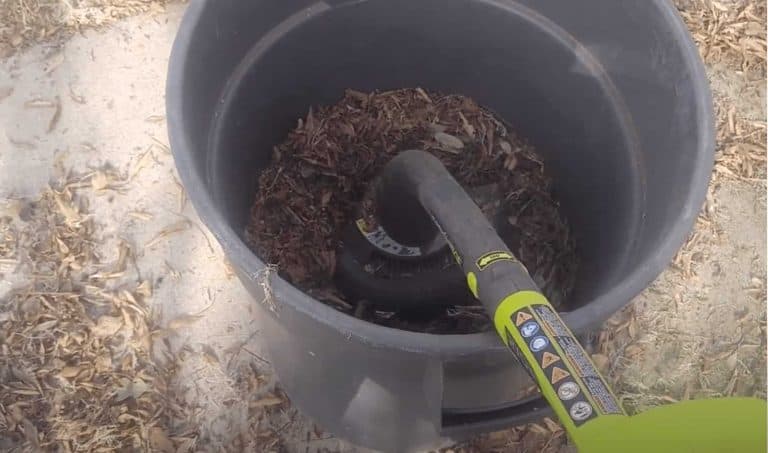
Fill a garbage can about 1/2 way with leaves, lower your weed wacker into the middle of the pile and turn it on. The weed eater will chew your leaves up within a few minutes.
Try not to overpack the leaves as you’ll want to be able to move the trimmer up and down safely.
Use a leaf shredder
A leaf shredder is a tool made for the sole purpose of shredding leaves.
They have wide openings so you can chuck a lot of leaves in at one time. Then the machine will mulch them using a line trimmer. You can attach a bag, or place a bin under the shredder to collect the leaves. Saving you the time and effort of raking them up after.
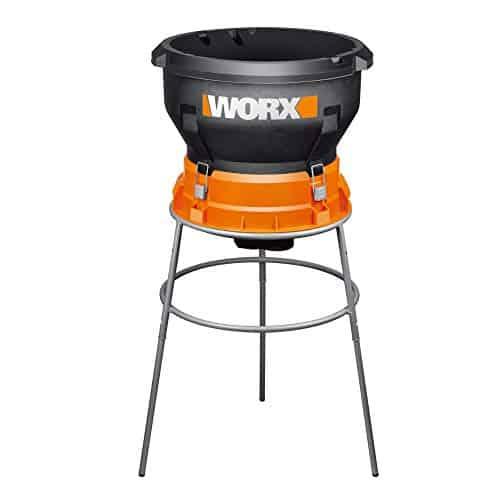
Leaf shredders are easy to use and efficient. Some of them even come with different settings so you can pick how coarse or fine you want the output.
If you’re considering buying a leaf shredder but often have lots of twigs mixed into your leaf piles you should consider a chipper shredder. This is a more powerful alternative that’s better at dealing with stray branches.
Chipper shredders are also useful for other composting needs such as creating wood chips to use as mulch.
Use a leaf vacuum
The final tool you can use is a leaf vacuum.
The advantage of using one of these is that you don’t have to collect the leaves by hand. You just need to walk around and vacuum them up.
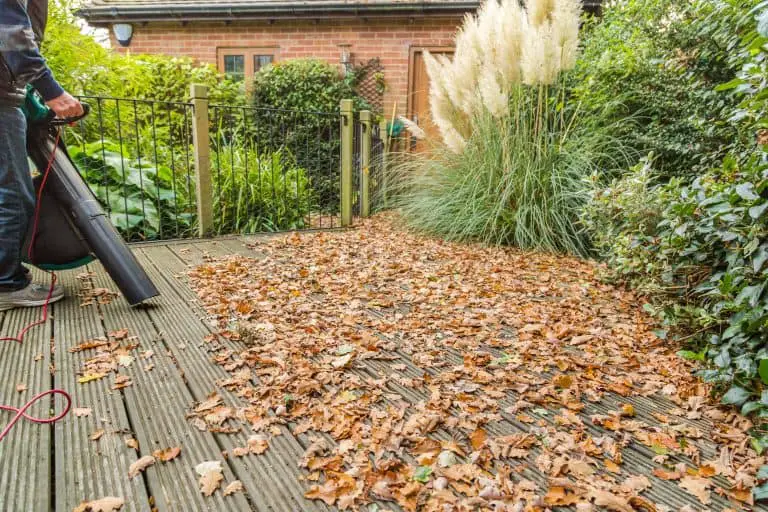
The vacuum will mulch the leaves and deposit them into the attached collection bag.
Typically these collection bags are quite small because you have to be able to carry them. If you have a lot of leaves to collect, you’ll have to empty the bag quite a few times, which can get annoying.
Jump on the leaves
Who doesn’t enjoy jumping on a pile of leaves?
While not the most efficient method, jumping on your leaves is by far the most fun. Your kids can get involved too.
Jumping works best if the leaves are crisp and dry. Let them dry out for a few days before crunching them if you think they’re too wet.
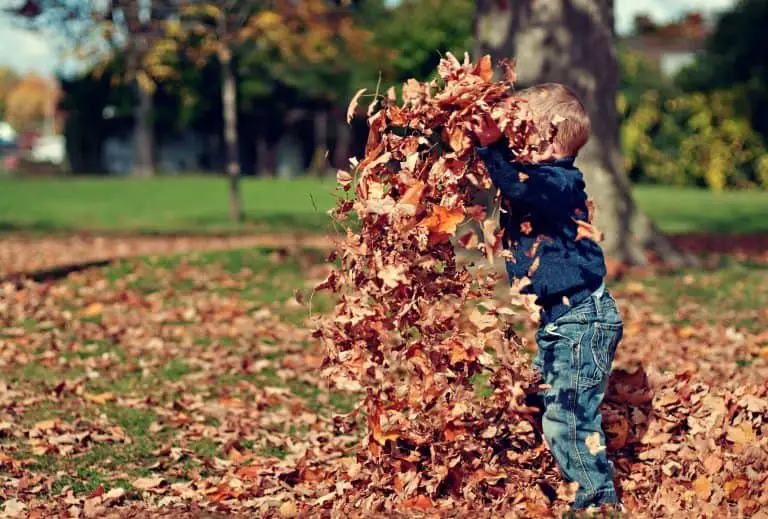
Putting the leaves in trash bags before you jump on them is a good way to avoid making a mess. It also makes the collection afterwards easy.
A variation on this method is to cover your walkways with leaves. As people walk over them, they’ll slowly grind them down until they’re suitable to compost.
This is a slower process than jumping, so best if you don’t mind waiting.
Drive over them
Driving over your leaves is a smart way to crush a big load of leaves in one go. It’s also quiet, and you won’t be exposed to any dust, so this is a good choice if you’re sensitive.
Layer the leaves around your driveway and then drive the car over them from a few different angles.
You’ll have to rake the leaves up afterwards, but luckily the car won’t spread them too far.
Use chickens
If you own some chickens, then you can put them to work ripping up your leaves.
Put the leaves in their enclosure, and they’ll tear through them looking for tasty bugs to eat. They’ll also add some chicken manure into the mix while they’re at it – an added benefit.
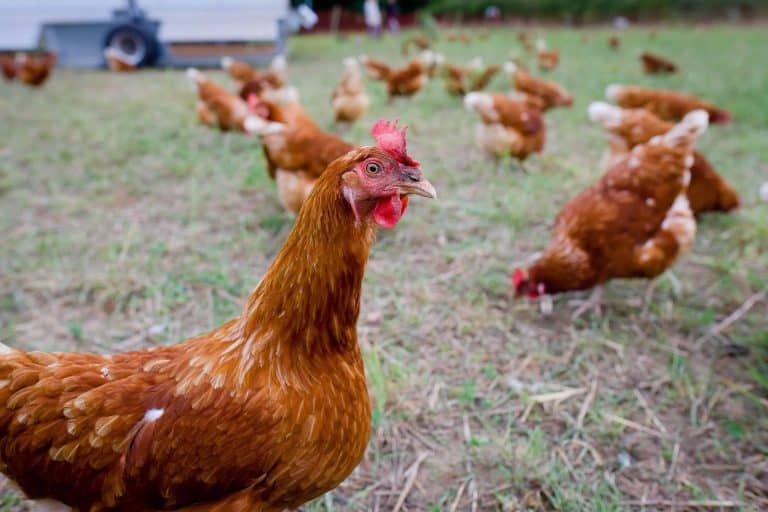
This method is super simple. All you have to do is collect the ripped up leaves when the chickens are finished.
What leaves shouldn’t I compost?
Not all leaves are suitable for composting.
It’s not advisable to add diseased leaves unless you can guarantee your compost pile will reach high enough temperatures to kill the harmful pathogens. Otherwise, the pathogens will live on in your leaf compost, and then possibly your plants.
You should also steer clear of black walnut and eucalyptus leaves because they contain natural herbicides that can stop seeds from sprouting.
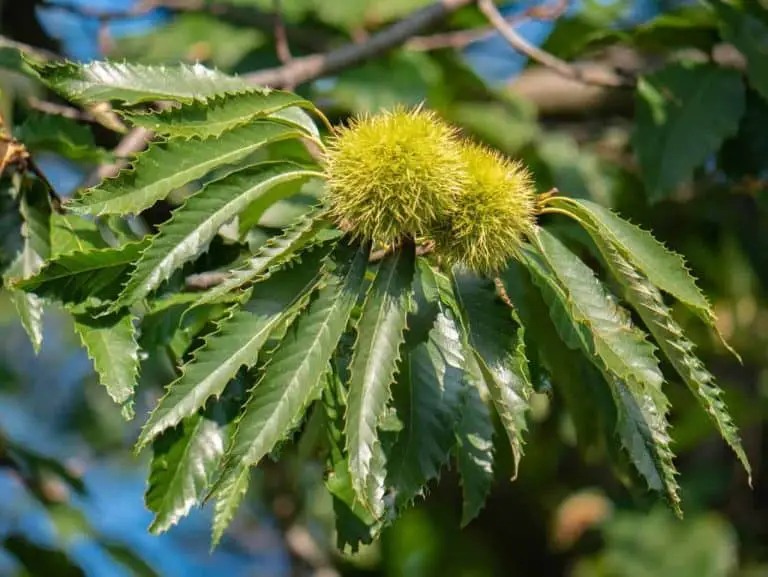
Finally, some leaves such as sycamore, sweet chestnut, or holly can take a long time to decompose fully. These thick, waxy leaves contain high levels of lignin, which is hard for microbes to digest and breakdown. If you have a lot of these leaves, it’s best to compost them separately, so they don’t slow down the rest of the compost heap.
What are the benefits of shredding leaves?
You might come across a few people who tell you there’s no need for any shredding before you compost leaves, that you’re putting in extra work for no reason.
However, this isn’t true. There are several benefits to shredding leaves for compost, which is why we continue to do it year after year.
First off, torn leaves decompose faster. By breaking a leaf up into smaller pieces, you’re increasing the surface area of that leaf.
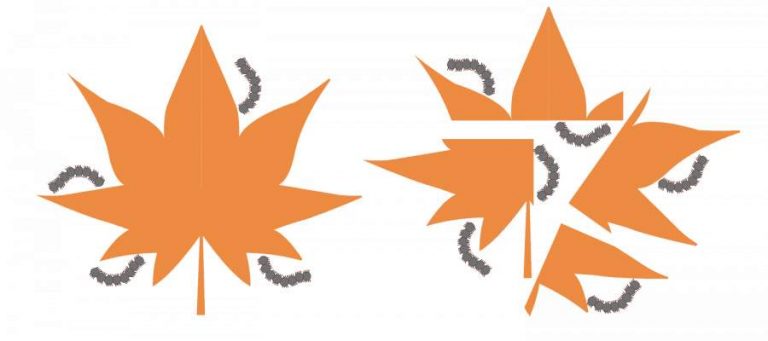
An increased surface area means that the microbes in your compost pile can reach more of the leaf. And therefore, it can be broken down much quicker.
Another way shredding leaves speeds up the composting process is by allowing more oxygen and water to flow.
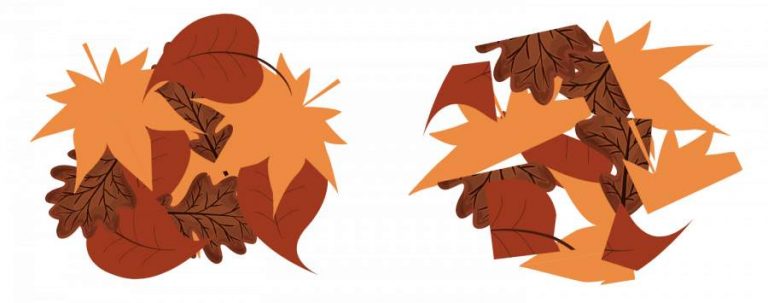
Large flat leaves can stick together and form tight layers which are hard to penetrate. This blocks air and moisture, two of the most important ingredients in composting, from circulating within your pile and dramatically slows down decomposition.
When you shred the leaves, they’ll no longer form compressed layers so air and moisture can infiltrate right to the core of your pile.
The third benefit of shredding leaves is the reduced volume.
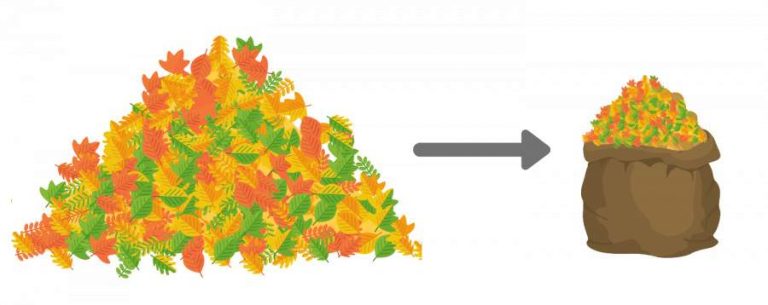
If you’re limited on space, then it can be impractical to store large quantities of leaves. Shredding them will reduce your pile down to a fraction of its original size. The most efficient shredding methods can reduce the overall volume by up to 95%.
What can I use shredded leaves for?
Once you’ve shredded the leaves, you can use then to make compost. But there are also a few other uses for them.
You can start making leaf mold, use the leaves as mulch around the garden, or add them straight to your soil.
Composting leaves
Shredded leaves make a great ‘brown material’ for your compost pile because they’re high in carbon, absorbent, and add structure. Combined these speed up the composting process and prevent bad odors.
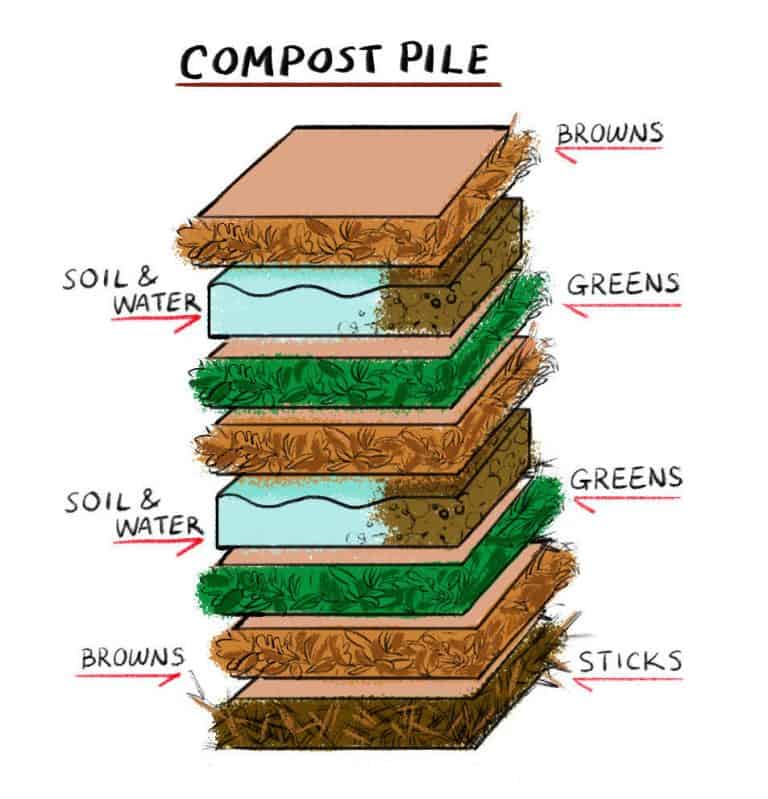
In our recommended lasagne method of composting, you alternate layers of leaves with your green material (i.e. kitchen scraps), mixing in some soil and water as you go to keep the pile moist. This method helps make sure you’ve got the correct brown:green ratio in your heap, which ensures a clean and fast decomposition.
As we explained above, shredding the leaves is important before you add them to your compost bin so they don’t form a compact layer and stop air or water circulating.
If you already have a compost pile, but think it’s too wet or not aerated enough then adding ground up leaves is a great way to soak up the excess moisture and fluff the heap up a bit. Turn the pile after adding the leaves, and you should have a hot steaming pile in no time!
One thing you should avoid using shredded leaves for is a composting toilet cover material. When they get mixed with urine, they can start to smell pretty bad, which is not what you want from a cover material.
Making leaf mold
Leaf mold, otherwise known as leaf compost, is compost made entirely from leaves. It’s straightforward to make and has fantastic benefits when used as a soil amendment.
Leaf mold can retain up to 500% of its weight in water, so massively increases how much water your soil can hold. It also helps improve soil porosity and create a habitat that worms and good bacteria thrive in. While it’s not as nutrient-rich as compost, leaf mold does add trace minerals such as magnesium and calcium to your soil.
It also makes great bedding for a worm farm!
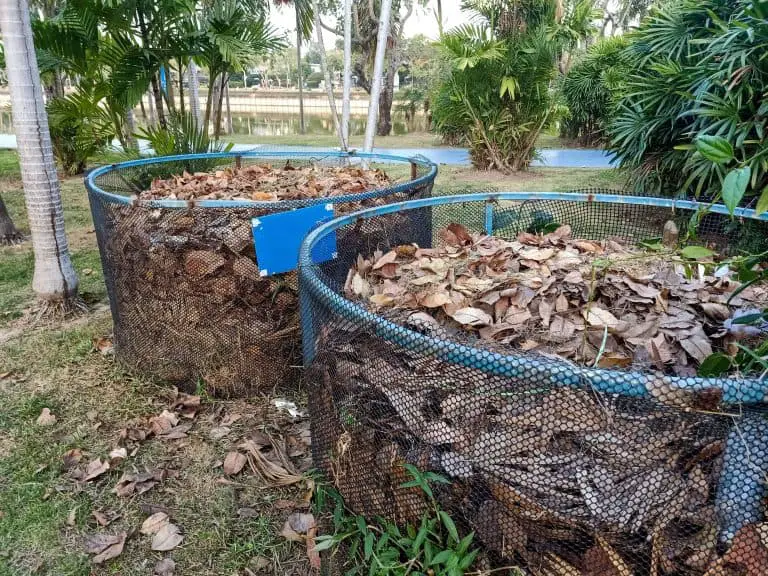
To make leaf mold, you need to pile up your leaves and house them in some wire mesh or a trash bag. If you don’t have some sort of compost bin, then the leaves will just blow away.
If you’re interested in getting a dedicated bin, make sure to check out our reviews of the best leaf composters.
Adding a small amount of nitrogen, such as grass clippings, chicken manure, or alfalfa meal will help kickstart decomposition.
As with any compost pile, maintaining the right level of moisture and aerating the pile will speed up the process. Leaf mold is slower than compost, but you should expect a usable product after around a year.
Be careful when opening the bag because leaf mold tends to get quite moldy, and you want to avoid breathing in all the spores.
Mulching / Insulation
Instead of waiting for your leaves to break down before adding them to your plant beds, you can add them straight away as mulch.
Add around 2-3 inches of mulch to your flower beds, vegetable gardens, or around trees and shrubs taking care not to touch the stems or trunks. Mulch helps the soil to retain moisture, keeps the ground cool, and prevents weeds from germinating. Over time the mulch will break down just as it would in a compost pile. This benefits the soil by attracting worms and improving the structure.
Shredded leaves can also insulate plants like roses that are sensitive to wintery conditions. Adding a thick blanket of mulch over your plants and vegetables will shield them from harsh winds and freezing temperatures.
In our guide to composting in the winter, we recommend keeping some leaves by so you can use them to insulate your pile over the winter.
Soil amendment
Lastly, you can mix your shredded leaves straight into your soil.
If you have a bed you want to prepare for planting, mixing in some mulched leaves is a great way to improve soil health.
A useful tip is to add some nitrogen rich organic matter along with the leaves.
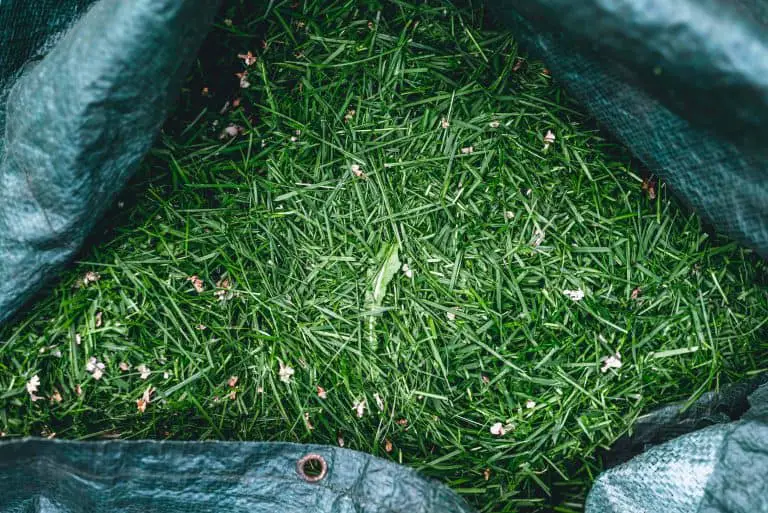
To decay leaves need a nitrogen source. If there isn’t one available, they’ll draw nitrogen from the soil making it less available to plants. Adding an extra nitrogen source such as grass clippings into the soil with your leaves solves this problem.
This is best practice when mulching as well.
Summary
Shredding leaves to make compost might seem like a mammoth task, and it might mean a bit of extra work.
But with the ideas in this article, hopefully, I’ve made the job seem a little easier (and more fun). I promise it’ll be worth it in the end for faster finished compost.
Have some wood chips that need composting quickly? I’ve got four ideas to help you.
